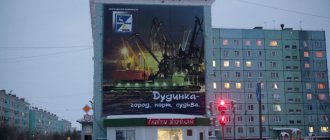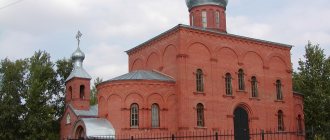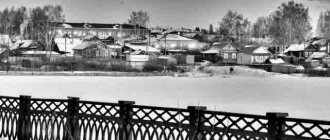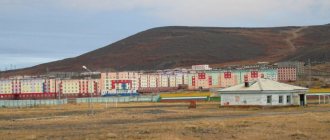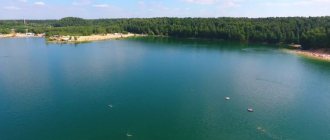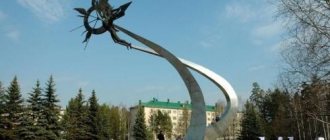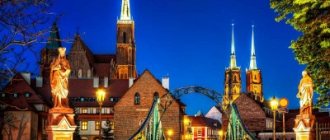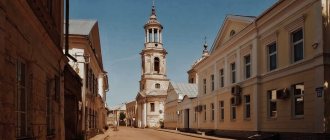For the city in Moscow Oblast, see Krasnoznamensk, Moscow Oblast.
City in Kaliningrad Oblast, Russia
| Krasnoznamensk Krasnoznamensk | |
| City [1] | |
| Krasnoznamensky District Administration building in Krasnoznamensk | |
| Flag Coat of arms | |
| Location Krasnoznamensk | |
| Krasnoznamensk Location Krasnoznamensk Show map of Russia Krasnoznamensk Krasnoznamensk (Kaliningrad region) Show map of Kaliningrad region | |
| Coordinates: 54°56′32″N 22°29′23″E / 54.94222°N Latitude 22.48972°E / 54.94222; 22.48972 Coordinates: 54°56′32″N 22°29′23″E / 54.94222°N Latitude 22.48972°E / 54.94222; 22.48972 | |
| A country | Russia |
| Federal subject | Kaliningrad region [1] |
| Administrative region | Krasnoznamensky district [1] |
| City of district significance | Krasnoznamensk [1] |
| Based | 1734 [2] |
| Height | 30 m (100 ft) |
| Population (2010 Census) [3] | |
| • General | 3,522 |
| • Evaluate (2018) [4] | 3188 ( -9,5% ) |
| Administrative status | |
| • Capital from | Krasnoznamensky district [5], city of regional significance Krasnoznamensk [5] |
| Municipal status | |
| • Urban district | Krasnoznamensky urban district [6] |
| • Capital from | Krasnoznamensky urban district [6] |
| Timezone | UTC+2 (MSK–1[7]) |
| Postal code [8] | 238730 |
| OKTMO ID | 27713000001 |
Krasnoznamensk
(Russian: Krasnoznamensk, lit.
Krasnoznamennoy gorod
), formerly
Lasdehnen
(1734–1938; Lithuanian: Lazdinaite) and
Haselberg
(1938–1946), is a city and administrative center in the Krasnoznamensky District of Kaliningrad Oblast, Russia, located on the Sheshupe River, in 163 km (101 mi) northeast of Kaliningrad, the administrative center of the region, and approximately 10 km (6.2 mi) south of the border with Lithuania. Population - 3,522 people (according to the 2010 census). [3]
Historically known as Lasdehnen, the city belonged to Prussia from 1701 and the German Empire with the unification of Germany in 1871 and was located in a province in East Prussia until 1945. During the Nazi Germany era it was renamed Haselberg until the territory was captured by the Soviet Union following World War II wars. The city was renamed Krasnoznamensk and became the administrative center of the Krasnoznamensky district in 1947.
History[edit]
The earliest surviving chronicle of Krasnoznamensk in German dates from 1521 under the title Haselpusch, which means hazel bush in German, while Russian sources give the date of the earliest record as 1576, and other sources claim it was set in 1734. [2] [ citation needed
] By 1578 there was a church in the village, but it burned down in 1661 and the new building had to be demolished in 1869 due to serious structural defects.
At the beginning of the 18th century, the town's name was changed to Lasdehnen, based on the Old Prussian language term for walnut bushes, and a now-Gothic Revival church was built between 1874 and 1877. [ edit
] As nationalism was still rising in much of Europe in the early 20th century, in 1938 the Nazi government Germanized the city's name, renaming it Haselberg (literally "hazel tree") due to Lasdenen's Baltic origins.
Church and river Sheshupe in Krasnoznamensk (formerly Lasdekhnen)
By 1945, during World War II, Haselberg's German population had largely fled before the Red Army offensive on 18 January. After the end of the war, Haselberg was included in the part of East Prussia annexed by the Soviet Union, which was organized into the Kaliningrad Oblast of the Russian SFSR. The historical capital of the region, nearby Schlossberg (still commonly known by its pre-1938 name Pillkallen, now Dobrovolsk) was seriously damaged during the war, so the Soviet authorities moved the former administrative functions of Pillkallen to Haselberg, which was less damaged. On April 7, 1946, the Soviets renamed the city Krasnoznamensk, literally "Red Banner City", and the following year it became the administrative center of the new Krasnoznamensky District. [2]
People don’t want to leave Krasnoznamensk, but they have to
The newspaper "Country Kaliningrad" continues to travel around regional cities. In October we went to Krasnoznamensk - a place that few people get to. This town is located on the outskirts: although it is not far from the border with Lithuania, there are no border crossings nearby. There are no large highways through it either. So there is peace and quiet there, and also a feeling that the locals live for today and don’t count too much on a mythical tomorrow. From a philosophical point of view, this may be correct, but in ordinary realities it leads to the fact that experts call the Krasnoznamensky urban district one of the most depressive in the region. There are no large enterprises, rapidly developing agriculture or other growth points here. One plant for all
While you are driving to Krasnoznamensk (the journey from Kaliningrad takes about three hours), already closer to the place, the thought “I wish I could live here” flashes every now and then.
Stunning forests, the Sheshupe River, crystal air and silence. There’s just a problem with this romance: to live, you need money, but there’s nowhere to get it from. This even affected officials: the head of the local administration, Vladimir Sytnyuk, last year was in penultimate place in terms of salaries among heads of municipalities with an amount of 54,600 rubles per month, and compared to 2015, his remuneration for work decreased noticeably (read more on our website strana39 .ru in the material “Anton Alikhanov receives less than Alexander Yaroshuk.” – Author’s note). In general, melancholy, albeit light. As local residents told us, on average people earn 10–12 thousand rubles. Once upon a time, jobs were provided by a huge forestry enterprise and various enterprises that were organized here after the war. Today, the opportunity to earn money is in the administration and other government agencies (for example, a multifunctional building, a children's art school), shops, and small farms. And also a school: in 2015, a modern building for a thousand children was built in Krasnoznamensk. It took almost seventy years to get to this event, and the construction itself lasted two years. According to the old Russian tradition, it was not possible to deliver everything on time, but, however, we were only three months behind schedule: either the contractor failed, or the elevator, which was ordered all the way from Germany, did not arrive. But in the end, the opening took place: the swimming pool, gyms and other joys of life became available to schoolchildren not only in Krasnoznamensk itself. To recruit the required number of students, children are brought here from all over the district (for this reason, some rural schools have closed). But the most jobs are provided by the “Fifth Element” brick production plant, which resonated throughout the country in winter - then the head of the region, Anton Alikhanov, ironically suggested that the Lithuanians buy bricks from us to build a wall on the border. True, there are rumors among the locals that serious cuts are being made there, and no one knows what they will lead to. People hoped for the construction of the Baltic nuclear power plant, but it hasn’t happened yet: many of those who got a job there now go to the regional center to work at the thermal power plant. In general, the situation when the head of the family is at home only on weekends is not uncommon here: men are forced to look for work in Sovetsk, Kaliningrad, and you cannot travel such distances every day. – While we live in Krasnoznamensk, my wife and I have a small child, and this is a great place for children: there is a kindergarten and a school, the environment is excellent. There is no work in the city, but I go to sea, so everything is fine with us. And I know that men travel on rotation even to the North to earn extra money. In general, we like it here, but we understand that over time we will need to move,” shares the head of the young family, Georgy. Vegetable gardens help to survive.
In the villages around Krasnoznamensk, the situation is also deplorable: the forest (berries and mushrooms are sold in large quantities to buyers in Kaliningrad), the river and subsidiary farming help to feed.
Most people keep livestock. – We sell milk at a good price - this year it was raised to 26 rubles 70 kopecks. This is much more than our neighbors in Lithuania, so we’re not complaining,” residents of the village shared with SK journalists. Nemanskoe. But what they complain about in regional villages is transport. For example, it is difficult to get to and from the Nemansky district, which is 17 kilometers from Krasnoznamensk, to the hospital and other institutions located there. The bus runs only three times a week: in the morning - there, in the afternoon - back. And if you didn’t have time to quickly settle everything, how to get home? Sovetsk and other, more remote places are generally inaccessible without your own transport. Everyone we talked to that day said that they didn’t want to move from their beloved city. It has become prettier in recent years: the roads and sidewalks have been put in order, the houses are being restored. – A few months ago I moved to Kaliningrad with my children. They had been there for a long time, settled down and called me. Here I worked as a nurse in a hospital, received 10 thousand rubles, spent 3 thousand of them on utilities - so think about how to live on the rest. My friend works as a postman for 9,000 rubles a month: she walks around a huge area, because she wasn’t even given a bicycle - she has to buy it herself. So, vegetable gardens and their own farms help people survive,” former local resident Elena told us. – So I moved, although I lived here for 28 years and love these places. There is life here: an excellent House of Culture, good housing, gas installed. But there are no prospects. By the way, about the Central Regional Hospital, where Elena worked: renovations there have been going on since 2014 and everything will not be completed. The reason for this is the traditional leapfrog with contractors, and the facade and roof are still not completed. - They say that the work is about to end. But, to be honest, I can’t believe it anymore,” local residents admit. They move for the sake of silence
Of course, not everyone leaves.
If work is in order, then living in Krasnoznamensk is comfortable. - It’s beautiful here. There were times when I had problems getting into kindergarten, but now everything is fine. A school has been built, playgrounds have been built, and a bicycle path will appear soon,” Alla talks about the advantages of his beloved city. We also met those who are moving to quiet places from other cities and even countries (according to the stories of residents, migrants from Kazakhstan and Armenia are actively coming here). – My wife and I moved to the village. Alekseevka in the early 2000s. We bought a cheap house and land, and I opened a car wash in the city. We like it here - beautiful, quiet, fishing and hunting. Although I won’t say that everything is simple: last year I had two employees, but I had to fire everyone, and now I work on my own - people have less and less money, and this affects everyone,” entrepreneur Ian shared with SK correspondents. Officially
Sergey Shapovalov, acting. O. Deputy Head of the Administration of the Krasnoznamensky City District: - We are working to ensure that new enterprises and jobs appear in the district. Next year, a large poultry complex of the Guryev Poultry Farm will open in the village. February, 90% of it is already ready. There will be 42 jobs there – this is a good number for us. We are located far from the regional center, so it is not easy to develop, but it is clear that we need to pay attention to agriculture. I remember that we once had a cheese factory, sausage shops, and in the 2000s there was a TV assembly plant. There are still prospects today. The renovation of the district hospital should be completed this year: on October 24, a competition was held and a contractor was selected to complete the renovation of the facade and roof in the amount of 2.9 million rubles. The company is proven, with experience - I am sure that they will be able to finish everything in the 45 days allocated to them for this. And a bicycle path will definitely appear in Krasnoznamensk: we are participating in the cross-border cooperation program and next year, as part of tourism development, we will build a four-kilometer route. We plan to increase it in the future.
Administration: - We have undergone an internal audit, and indeed there are reductions, but they did not affect the main employees: we removed duplicate positions, outsourced our own security (there were 12 people). If we talk about numbers, then instead of 200 people by the end of November there will be 165. All employees affected by the reduction received notification in advance. But the plant is not closing under any circumstances: the owner is interested in developing this business. We have our own sand and clay quarries; we have extracted several years worth of raw materials. We have already increased the volume of production of ceramic bricks; large construction companies in the Kaliningrad region use it.
share Facebook
OK
tags region Krasnoznamensk Kaliningrad
Administrative and municipal status[edit]
As part of its administrative divisions, Krasnoznamensk serves as the administrative center of Krasnoznamensky District. [5] As an administrative division, together with two rural settlements it is part of the Krasnoznamensky district as a city of regional significance of Krasnoznamensk
. [5]
As part of the municipal formation, from May 5, 2015, the territories of the city of regional significance of Krasnoznamensk and three rural districts of the Krasnoznamensky district were included in the Krasnoznamensky urban district. [6] Before this, the city of regional significance was part of the Krasnoznamensky municipal district as the urban settlement of Krasnoznamensky
. [6]
“The city of built communism” Krasnoznamensk: Life in the closed city as it is
Traffic jams at the entrance
But the fence and checkpoint are, of course, not only advantages.
The presence of access control leads to traffic jams at the exit from the city in the morning and at the entrance to it in the evening, since, at its core, Krasnoznamensk is a residential area slightly remote from the capital, and the lion's share of residents (those who do not serve in the army) work in Moscow. Imagine yourself, you got out of the capital, overcame all its many kilometers of traffic jams, got to the town and... you can easily stand in a traffic jam at the checkpoint for another 15-30 minutes. And if it’s related to military exercises, then even longer. Fortunately, they do not happen so often - a couple of times a year. I’ll also say separately about issuing passes for those who are coming to see you - friends, relatives, or just delivering something. Let me note that to simplify the procedure, these must be Russian citizens and in cars with Russian license plates (with foreigners everything is much more complicated). In order to order a pass, you need to come to the checkpoint and leave a handwritten application. There is no electronic application option, although residents have been asking for one for a long time. It’s good at least that, according to unspoken rules, the application is submitted without a queue. And sometimes they are quite large at the pass office, and if your guests are unlucky, they can spend quite a long time in such a queue to receive a pass. At the same time, a one-time pass is valid for a maximum of five days, and it needs to be extended if your relatives are delayed. And this means going through everything again. And the pass offices are located at only two checkpoints...
Creative party
But let's get back to the positives. The fame of the city as a quiet place spread quite widely, especially in creative circles. And many artists do not hesitate to live either in the city or near it in order to be able to enjoy its benefits. Unfortunately, the late actor Alexei Buldakov spent the last years of his life in Krasnoznamensk, Tarzan and Natasha Koroleva live next door, Edgard Zapashny and actor Oleg Vasilkov visit the city, at one time Kirill Andreev from “Ivanushki” built a house here, and director Maxim Aksenov, who became famous in the KVN team “Children of Lieutenant Schmidt,” became a local resident almost 20 years ago.
“I have a habit: I first explore all new cities where I come with my feet, that is, I walk, I walk - I did the same in our city,” Aksenov once said. - And since then I’ve been walking here regularly - I really like to walk from one end of Krasnoznamensk to the other, often even, if I need to go somewhere, I do without a car. You walk, look around, breathe easily... Beauty! This is what got me hooked on the city – its coziness, compactness and atmosphere.”
“I really liked Krasnoznamensk: very close to Moscow, quiet, cozy, closed, you can calmly walk at any time of the day, without any fear for your life - and this is Kirill Andreev. – I really liked the park area next to the lake, where there are many benches. I loved to sit there on a summer evening and take my mind off my problems.”
Agree, very similar words. And actors Alexander Palchikov and Tatyana Lyannik, singers Irina Toneva from “Factory” and Oleg Sidorov, who were either born in the city or spent their childhood and youth in it, arriving with their military parents, can easily subscribe to them.
It is not surprising that Krasnoznamensk is known in the area as the best place to raise children, because you can let them go out without any problems, you don’t have to take them to school almost until graduation, since the town is quite compact. In general, everything is almost like during the USSR throughout the country. “The city of mothers with strollers” - this is what the townspeople say about Krasnoznamensk. Which is not surprising, because during the day the city is given over to them - the bulk of the residents are in Moscow, and the military personnel are on duty or resting after it.
But perhaps a more accurate definition of the city was given by one of the bloggers. They were invited to explore the city about a dozen years ago. It was summer, and at this time of year Krasnoznamensk is most beautiful, as it is surrounded by greenery. Many even have the feeling that this is a resort and somewhere around the corner is the sea. Of course, there is no sea, but there is a lake with a gorgeous beach, which this summer resembles Gelendzhik with its crowds of people.
But let's get back to bloggers. They walked around then, looked at the mothers with strollers, and came to the conclusion that “Krasnoznamensk is a city of built communism.” This is, of course, a long way off – there are plenty of problems, but the essence was captured correctly.
Demographics[edit]
Demographic trends[edit]
- 1,294 (1885 census)[9]
- 1857 (1910 census) [10]
- 2,065 (1933 census)[9]
- 2,070 (1939 census)[9]
- 2843 (1959 census)
- 2911 (1970 census)
- 3,392 (1979 census) [11]
- 3,894 (1989 census) [12]
- 3,751 (2002 census) [13]
- 3,522 (2010 census) [3]
Ethnic composition[edit]
According to the 2010 census: Russians - 87.4%, Lithuanians - 2.8%, Ukrainians - 2.5%, Belarusians - 2.5%, Roma - 1%, Armenians - 1%, Germans - 0.9%, Tatars - 0.6%, Poles - 0.5%. , others - 0.8%
Krasnoznamensk is in the ethnographic region known as Lithuania Minor, and Lithuanian cultural organizations exist in the city. [14]
Where religion is recorded in the census process, census data prior to 1945 show the religious affiliation of the population as Prussian-Evangelical.
Schedule at the cash control center in Krasnoznamensk
Schedule at the cash control center in Krasnoznamensk
| SCHEDULE | |||||
| movement of buses through the cash register and dispatch center in Krasnoznamensk | |||||
| ADDRESS: 238730, Krasnoznamensk, st. Sovetskaya, 54 | |||||
| WORKING MODE: 06:00 - 17:10, break: 08:30-09:30, 10:15 - 11:30, 14:15 - 16:00 | |||||
| Sunday: 08:00 - 17:10, break: 08:30-09:30, 10:15 - 11:30, 14:15 - 16:00 | |||||
| day off - Saturday | |||||
| TELEPHONE cash register - control center extension 302 | |||||
| route number | departure time from Krasnoznamensk | time of arrival at final destination | Bus routes and main intermediate points | departure time from final destination | time of arrival in Krasnoznamensk |
| 1. | 2. | 3. | 4. | 5. | 6. |
| MUNICIPAL ROUTES | |||||
| 190 | 07-38 14-00 | 08-33 14-59 | Krasnoznamensk - village. VESNOVO through the village. Belkino, village Nodal Monday, Thursday | 08-40 15-05 | 09-30 16-00 |
| 194 | 06-20 | 07-13 | Krasnoznamensk - village. PRAVDINO through the village. Michurino, village Pobedino except Monday, Thursday, Saturday | 07-16 | 07-50 |
| 14-45 | 15-14 | 15-15 | 15-58 | ||
| 195 | 06-30 | 07-03 | Krasnoznamensk-p. BORDER through the village. Zarechnoye Monday, Thursday | 07-05 | 07-38 |
| 12-25 | 12-52 | 12-55 | 13-55 | ||
| 196 | 06-00 | 07-35 | Krasnoznamensk - village. NEMANSKOYE through the village. Maly Poselok except Monday, Thursday, Saturday | 13-20 | 14-45 |
| 196 | 06-53 | 07-35 | Krasnoznamensk - village. NEMANSKOE via Alekseevka Monday, Thursday, Saturday | 13-20 | 14-45 |
| 197 | 08-00 | 09-25 | Krasnoznamensk - village. VESNOVO through the village. Dobrovolsk | 11-00 | 11-55 |
| 12-20 | 13-15 | 15-11 | 15-58 | ||
| 16-00 | 16-55 | 18-31 | 19-25 | ||
| INTERMUNICIPAL ROUTES | |||||
| 321 | 06-00 | 07-10 | Krasnoznamensk - SOVETSK | 08-50 | 09-57 |
| 10-00 | 11-05 | 12-25 | 13-44 | ||
| 14-00 | 15-35 | 15-40 | 16-54 | ||
| 17-10 | 18-10 | 18-20 | 19-50 | ||
| 380 | 11-40 | 12-38 | Krasnoznamensk - GUSEV city via the village. Vesnovo | 05-20 | 06-15 |
| 15-01 from Vesnovo | 15-31 | 14-30 to Vesnovo village | 15-00 | ||
| 20-15 | 21-13 | 12-40 | 13-32 | ||
| 381 | 10-51 | 11-21 | village Vesnovo - GUSEV town via the village. Kubanovka | 10-20 | 10-50 |
| 18-20 | 18-50 | 17-50 | 18-20 | ||
| 516 | Krasnoznamensk - KALININGRAD via Neman, Sovetsk, village. Bolshakovo, Gvardeysk | ||||
| 17-20 | 21-00 | ||||
| 526 | *06-20 | 11-21 | Krasnoznamensk - KALININGRAD via Gusev, Chernyakhovsk * - daily, except January 01 | *07-10 | 11-32 |
| 10-15 from Nesterov | 13-30 | 10-20 without Gvardeysk | 12-35 to Gusev | ||
| 13-35 | 18-24 | 12-55 | 15-25 to Gusev | ||
| 15-50 | 20-12 | ||||
| SCHEDULE is informational, subject to change. | |||||
| TELEPHONE for inquiries extension 302 | |||||
| main | |||||
This page shows the bus schedule for the ticket office in the city of Krasnoznamensk. The city operates municipal and intermunicipal routes. Be careful, flights on the municipal route Krasnoznamensk - village. Border crossings are carried out only twice a day, except Monday, Thursday and Saturday. The bus to the village of Vesnovo runs 5 times a day, some departure times are unavailable on Monday and Thursday.
On intermunicipal routes you can get to Sovetsk, Kaliningrad, and Gusev with intermediate stops in Gvardeysk and Chernyakhovsk. Some flights only operate twice a day, so plan your trip in advance.
Links[edit]
Notes[edit]
- ^ abcd Law No. 463
- ^ abc Encyclopedia of Russian Cities
. Moscow: Great Russian Encyclopedia. 2003. p. 219. ISBN 5-7107-7399-9. - ^ abc Federal State Statistics Service (2011). All-Russian population census 2010. Volume 1 [All-Russian Population Census 2010, vol. 1]. All-Russian Population Census 2010 [All-Russian Population Census 2010] (in Russian). Federal State Statistics Service.
- "26. The size of the permanent population of the Russian Federation by municipalities as of January 1, 2022". Federal State Statistics Service. Retrieved January 23, 2022.
- ^ abcd Resolution #640
- ^ abcd Law No. 419
- "On the Calculation of Time". Official Internet portal of legal information
. June 3, 2011. Retrieved January 19, 2022. - Post office. Information and computing center of OASU RPO. ( Post office
).
Search for postal service objects ( postal Search for objects
) (in Russian) - ^ abc https://www.geschichte-on-demand.de/pillkallen.html 1885 census data: note that the town was then identified as "Haselberg (früher Lasdehnen)" (Haselberg (formerly Lasdehnen))
- https://www.gemeindeverzeichnis.de/gem1900//gem1900.htm?ostpreussen/pillkallen.htm 1910 census data: note that the city was then called Lasdehnen
- All-Union Population Census of 1979. National composition of the population by regions of Russia. Ethnic composition of the population by regions of Russia. Demoscope Weekly (website of the Institute of Demography of the State University - Higher School of Economics
). 1979. Retrieved November 25, 2008. - All-Union Population Census of 1989 Population of Union and Autonomous Republics, Autonomous Regions and Districts, Territories, Regions, Urban Settlements and Village District Centers [All-Union Population Census of 1989: Current Population of Union and Autonomous Republics, Autonomous Regions and Districts, Territories, Regions , districts, urban settlements and villages performing the functions of district administrative centers]. All-Union Population Census of 1989 [All-Union Population Census of 1989] (in Russian). Institute of Demography of the National Research University: Higher School of Economics [Institute of Demography of the National Research University: Higher School of Economics]. 1989 - via Demoscope Weekly
. - ↑
Federal State Statistics Service of Russia (May 21, 2004). The population of the Russian Federation, cities of the Russian Federation as part of federal districts, urban settlements, settlements, settlements, settlements is 3 thousand or more people. [Population of Russia, its federal districts , subjects of the Federation, districts, urban settlements, rural settlements - administrative centers and rural settlements with a population of more than 3000 people] (XLS). All-Russian Population Census of 2002 [All-Russian Population Census of 2002] (in Russian). - [1]
Dam and locks
On the banks of the Sheshupe River there is a hydraulic structure that harmoniously fits into the picturesque landscape surrounding the dam. The sound of falling water can be heard long before approaching the historical site.
The locks and dam were built at the beginning of the twentieth century and, after reconstruction in 2010, are in good condition.
The hydroelectric power plant supplied electricity to the city of Lazdenen and nearby settlements in the district. It also generated electricity in the post-war period. Not far from the dam there is a bridge across the Sheshupe River.
Kirch Stüler
Having passed through the bridge, the main attraction of Krasnoznamensk opens up - a 40-meter high church, built in 1875 according to the design of Friedrich August Stüler, one of the most significant architects of European classicism and historicism.
August Stüler
Stüler created his creations in many cities and made a significant contribution to European architecture of that time. A beautiful temple was erected instead of a destroyed church built in 1578. A masterpiece of religious architecture, it is a three-nave brick basilica with a tower, a polygonal choir and stepped pediments.
After the war, the former evangelical church housed a garage and various warehouses. In 1991, the church became the property of the Russian Orthodox Church. Nowadays, it houses the Orthodox Church of the Apostles Peter and Paul of the Chernyakhov diocese of the Russian Orthodox Church.
